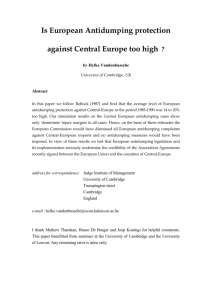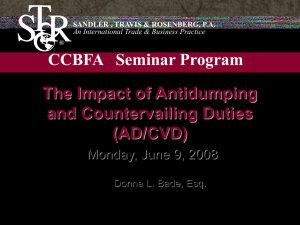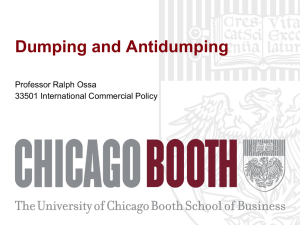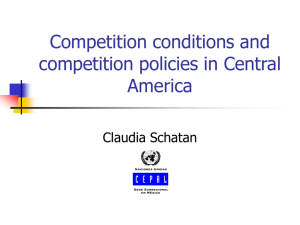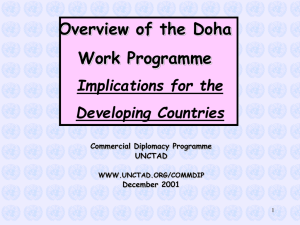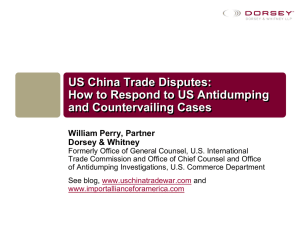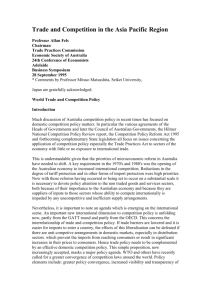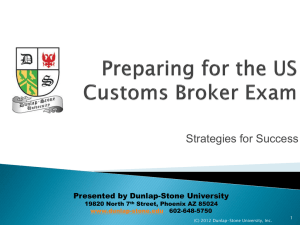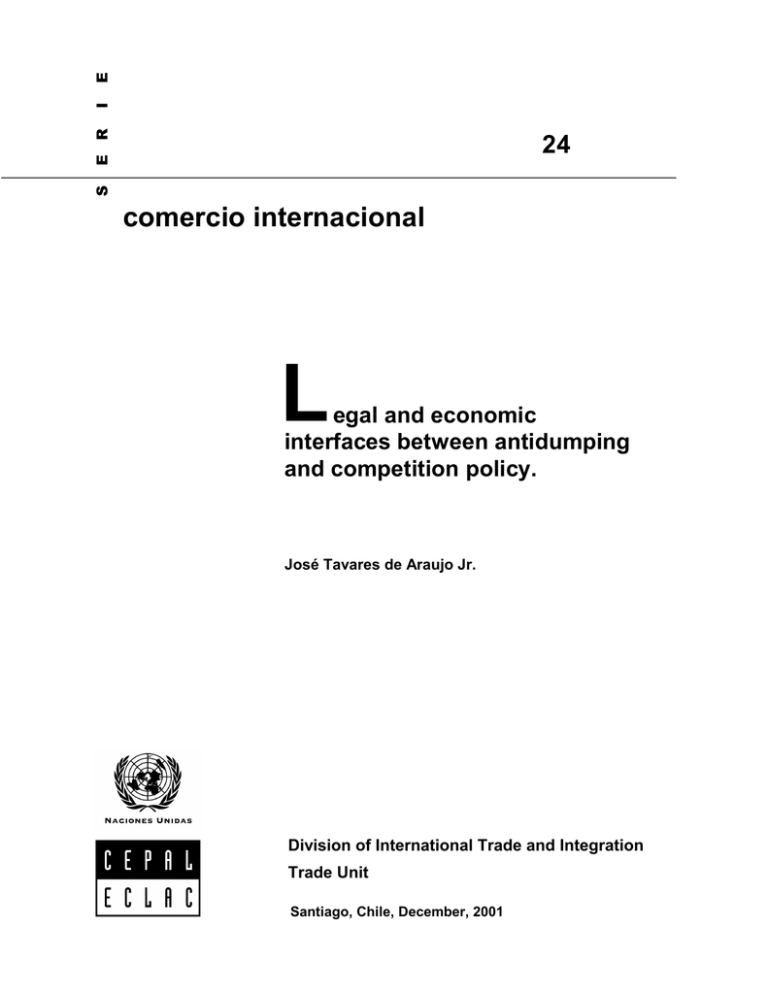
E
I
E R
S
24
comercio internacional
L
egal and economic
interfaces between antidumping
and competition policy.
José Tavares de Araujo Jr.
Division of International Trade and Integration
Trade Unit
Santiago, Chile, December, 2001
This document was prepared by José Tavares, Consultant of the Division of
International Trade and Integration of ECLAC.
The views expressed in this document, which has been reproduced without
formal editing, are those of the author and do not necessarily reflect the views of
the Organization.
United Nations Publications
LC/L.1685-P
ISBN: 92-1-121345-2
ISSN: 1680-869X
Copyright © United Nations, December 2001 All rights reserved
Sales N° : E.01.II.G.222
Printed in United Nations, Santiago, Chile
Applications to the right to reproduce this work are welcomed and should be sent to the
Secretary of the Publications Board, United Nations headquarters, New York, N.Y.
10017, U.S.A. Member states and their governmental institutions may reproduce this
work without prior authorization, but are requested to mention the source and inform the
United Nations of such reproduction.
CEPAL - SERIE Comercio internacional
N°24
Contents
Abstract
.............................................................................. 5
I. Introduction....................................................................... 7
II. The Controversy on Antidumping. .................................. 9
III. The Room for Compromising Solutions. ...................... 13
A. The Legal Interface.............................................................. 13
B. The Economic Interface ................................................ 15
IV. The FTAA Peculiarities ................................................... 17
V. Conclusion ...................................................................... 21
Bibliography........................................................................... 23
Serie Comercio Internacional: Issues published................... 25
Tables
Table 1: Antidumping Investigations within the Wester
Hemisphere, 1987-2000....................................................... 18
3
CEPAL - SERIE Comercio internacional
N°24
Abstract
The interaction between antidumping and antitrust is a polemic
issue in every integration process for both legal and economic reasons.
From a legal perspective, antidumping rules allow practices such as
price undertakings and quantitative trade restrictions that are
forbidden by competition law, and punish certain types of price
differentiation that are justifiable under the antitrust rules. From an
economic viewpoint, the two policies pursue different objectives that
eventually may lead to conflicting situations. Antidumping is a trade
remedy for industries injured by import competition. The final goal of
antitrust is to promote consumer welfare and productive efficiency,
which in part depend upon market contestability, wherein import
competition often plays a key role.
This paper addresses several issues from three complementary
perspectives. Section 2 summarizes the current debate about
antidumping rules in the United States. This debate includes a large
and growing academic literature that has been surveyed recently by
Blonigen and Prusa (2001), papers and speeches by influential
personalities such as Kenneth Dam, Alan Greenspan and Joseph
Stiglitz, and the active participation of business associations, lawyers,
lobbyists and politicians. This diverse collection of policy suggestions
provides a normative background for the discussion in the rest of the
paper. Section 3 reviews the instruments used by the European Union
and the U.S. government for reconciling a strong enforcement of
competition laws with an intense use of antidumping measures. Section
4 highlights some peculiarities of the FTAA process. Section 5
presents the main conclusions.
5
Legal and Economic Interfaces Between Antidumping and Competition Policy
6
CEPAL - SERIE Comercio internacional
I.
N°24
Introduction
1
The interaction between antidumping and antitrust is a polemic
issue in every integration process for both legal and economic reasons.
From a legal perspective, antidumping rules allow practices such as
price undertakings and quantitative trade restrictions that are
forbidden by competition law, and punish certain types of price
differentiation that are justifiable under the antitrust rules. From an
economic viewpoint, the two policies pursue different objectives that
eventually may lead to conflicting situations. Antidumping is a trade
remedy for industries injured by import competition. The final goal of
antitrust is to promote consumer welfare and productive efficiency,
which in part depend upon market contestability, wherein import
competition often plays a key role.
The enforcement procedures of these policies also differ
significantly. Antidumping procedures are defined under the
assumption that a domestic competitive industry is facing a foreign
monopolist or an international cartel, but this assumption is not
supposed to be tested during the investigation. Thus, in each case, the
data to be collected are limited to import figures, price comparisons
and performance indicators of the domestic industry. There is no room
for any query about industry configurations, entry barriers, market
power and other conditions of competition at home or abroad. In
contrast, the starting point of every antitrust inquiry is the identification
1
I thank Caldwell Harrop and Karsten Steinfatt for helpful suggestions, and Mariana Tavares de Araujo for the research assistance on
legal matters.
7
Legal and economic interfaces between antidumping and competition policy
of the relevant market and its conditions of competition. Another peculiarity of the interplay
between antidumping and antitrust is that many industrialized economies are leading users of both
policies. This implies a series of compromising solutions with different degrees of coherence and
transparency for reconciling the legal and economic interfaces between the two policies. Some of
these solutions may provide useful guidelines for the current negotiations on the creation of a Free
Trade Area of the Americas (FTAA), where the attainment of a compromising solution will require
an intricate exercise of economic diplomacy. Besides the disparities in terms of size and level of
economic development of the member countries, one additional challenge to be faced by the FTAA
initiative results from the uneven degree of law enforcement in the region. In most Latin American
and Caribbean countries, antitrust institutions are still at an infant stage or simply do not exist. On
the other hand, the main users of antidumping in the hemisphere are the United States, Canada,
Mexico, Argentina and Brazil. The smaller economies seldom apply this policy (see Tavares,
Macario and Steinfatt, 2001).
This paper addresses the above issues from three complementary perspectives. Section 2
summarizes the current debate about antidumping rules in the United States. This debate includes a
large and growing academic literature that has been surveyed recently by Blonigen and Prusa
(2001), papers and speeches by influential personalities such as Kenneth Dam, Alan Greenspan and
Joseph Stiglitz, and the active participation of business associations, lawyers, lobbyists and
politicians. This diverse collection of policy suggestions provides a normative background for the
discussion in the rest of the paper. Section 3 reviews the instruments used by the European Union
and the U.S. government for reconciling a strong enforcement of competition laws with an intense use
of antidumping measures. Section 4 highlights some peculiarities of the FTAA process. Section 5
presents the main conclusions.
8
CEPAL - SERIE Comercio internacional
N°24
II. The Controversy on Antidumping
Thousands of pages have been written about antidumping over
the last 25 years. One remarkable feature of this vast literature is that –
at least within the academic community – most authors would share
Michael Finger’s view that “antidumping is a trouble-making
diplomacy, stupid economics and unprincipled law” (1993, p. 56).
According the existing multilateral rules, antidumping actions are
applied on a discriminatory basis and require no formal compensation
to the affected parties, as they are under the blame of unfair behavior.
Yet, in many cases the targeted exporting industries are well rewarded,
by sharing the protection rents with their competitors from the
importing country, but this compensation is never acknowledged by
either party. Thus, antidumping rules generate unnecessary tensions
among trading partners, because there is no clear record of the costs
and benefits involved in each case, nor any transparent recognition of
winners and losers. Moreover, the empirical literature has
demonstrated that the aggregate welfare results of antidumping
measures are systematically negative for the importing country.
Finally, antidumping rules have another discriminatory component, as
they impose requirements to foreign producers that are not applicable
to domestic firms.
In a similar vein, Kenneth Dam, deputy Treasure secretary of
the present Bush Administration, noted: “The focus of protectionist
arguments in the United States has turned away from direct calls for
protection to an emphasis on ‘fairness’. […] Despite this smiling fair
trade face, the antidumping proceeding always has been and is
increasingly a protectionist device, as various Congresses have
amended the underlying statute to make the proceeding and remedy
9
Legal and economic interfaces between antidumping and competition policy
more effective. This darker face of antidumping proceeding is so well known inside the
Washington Beltway that it has become a trite joke among trade lawyers that antidumping is the
protectionist’s weapon of choice2” (2001, p. 148).
Alan Greenspan, chairman of the Federal Reserve Board, pointed out the historical roots of
this joke: “Generation after generation has experienced episodes in which the technologically
obsolescent endeavored to undermine progress, often appealing to the very real short-term costs of
adjusting to a changing economic environment. From the Luddites to the Smoots and the Hawleys,
competitive forces were under attack. […] Administrative protection in the form of antidumping
suits and countervailing duties is a case in point. While these forms of protection have often been
imposed under the label of promoting ‘fair trade’, oftentimes they are just simple guises for
inhibiting competition” (1999, p. 3).”
Joseph Stiglitz, a Nobel Prize winner and former chief economist at the World Bank,
highlighted the anti-competitive effects of these laws: “Perpetuating unfair trade laws that are
themselves unfair thus imposes substantial burdens on our consumers and on our most efficient
exporters while protecting our least efficient import-competing firms” (1997, p. 418).
Great part of the academic research on antidumping has been focused on the American
economy. One reason for this is that the U.S. has maintained a leading international performance in
regard to this instrument, as the principal user and the second worldwide target of antidumping
investigations during the last decade (see Miranda, Torres and Ruiz, 1998). Another possible
explanation stems from the contrast between the scholars’ denigration of antidumping and the
longstanding commitment to this trade remedy by the U.S. government. Besides, as Blonigen and
Prusa (2001) have reminded, antidumping can provide stimulating illustrations for an endless list of
economic concepts, such as capture, rent-seeking, moral hazard, adverse selection, contingent
protection, imperfect competition, cartel behavior, transaction costs, optimal tariffs, comparative
advantage, regional integration, and so on.
Another interesting aspect of this controversy is that the most complete study so far on the
welfare impact of antidumping on the U.S. economy was made in 1995 by the staff of the
International Trade Commission (ITC), the institution responsible for this trade remedy in the
country. The study showed that removing the antidumping and countervailing duties that were
active in 1991 would have allowed a welfare gain of US$l.6 billion, i.e., about 0.03 percent of U.S.
GDP in that year. This finding had no effect on the ITC conduct in subsequent years, for the
reasons bluntly explained by Commissioners Janet Nuzum and David Rohr in their comments on
the study: “…when viewing the conclusions of this report, it must be remembered that the purpose
of the antidumping and countervailing duty laws is not to protect consumers, but rather to protect
producers. Inevitably, some cost is associated with this purpose. However, unlike the antitrust laws,
which are designed to protect consumer interests, the function of the AD/CVD laws is, indeed, to
protect firms and workers engaged in production activities in the United States. So it should not
come as a surprise that the economic benefits of the remedies accrue to producers, and the
economic costs accrue to consumers. The United States Government, through legislation, has made
a conscious policy choice to provide these trade remedies in recognition of the reality that free and
open trade does not yet exist worldwide. […] The alternative to these trade remedies is most likely
to be politically-driven decisions, which may have even more profound costs to our economic
interests” (ITC, 1995, pp. VIII-IX)
In a communication to the World Trade Organization (WTO), the U.S. Government
presented the same argument under a more sophisticated format: "Contrary to the assumptions of
some economists, the antidumping rules are not intended as a remedy for the predatory pricing
2
According to Dam, the original author of this joke is Gary Horlick (1989).
10
CEPAL - SERIE Comercio internacional
N°24
practices of firms or as a remedy for any other private anti-competitive practices typically
condemned by competition laws. Rather, the antidumping rules are a trade remedy which WTO
Members have agreed is necessary to the maintenance of the multilateral trading system. Without
this and other trade remedies, there could have been no agreement on broader GATT and later
WTO packages of market-opening agreements, especially given imperfections which remain in the
multilateral trading system." (U.S. Government, 1998, p. 2)
In other words, antidumping is the price to be paid for the maintenance of an open trading
system among nations wherein some industries are not prepared to face import competition. It is a
safety valve – perhaps a cynical one – that ensures political support to trade liberalizing initiatives.
As Dam (2001) has argued: “The case for antidumping duties is thus not so much sound economic
policy but rather statecraft that channels protectionism to narrowly defined products and renders it
less harmful to the economy as a whole” (p. 156).
Among trade economists, the standard reply to the above reasoning is that the correct
instrument for providing temporary protection to inefficient industries is a safeguard measure, not
antidumping (Nicolaides and Van Wijngaarden, 1993; Messerlin, 1996; Finger 1998; Tavares,
Macario and Steinfatt, 2001). Safeguards are more transparent, less belligerent and better focused
than antidumping. Instead of blaming foreigners for the country’s trading problems, safeguards
direct the government’s attention to the domestic factors that may be limiting the competitiveness
of local firms. But governments prefer antidumping because it is easier to apply. It does not require
negotiating compensations with trading partners, nor implementing industrial restructuring
programs at home.
Over the last two decades several proposals have been made to improve the disciplines on
antidumping. They varied from bold initiatives that would replace antidumping with competition
law to narrow reforms that would introduce some antitrust principles into antidumping
investigations, such as analyzing the conditions of competition in the importing country and
abroad, or examining the aggregate welfare consequences of that protection measure (Hoekman
and Mavroidis, 1996; Hart, 1997; Lipstein, 1997; Stiglitz, 1997; Lloyd and Vautier, 1999;
Messerlin and Tharakan, 1999; Lloyd, 2001). But instead of more rigorous, the WTO rules on this
matter became more flexible, due in part to the lack of a multilateral framework for dealing with
competition issues. Nowadays, perhaps the only mechanism that engenders some parsimony on the
use of this trade remedy is the effort made by some governments to avoid daily conflicts between
antidumping and competition law enforcement in their domestic economies, as the next section
shows.
11
CEPAL - SERIE Comercio internacional
N°24
III. The Room for Compromising
Solutions
The effort to reconcile a serious enforcement of competition law
with an active use of antidumping measures implies a difficult
challenge for any government, as the experiences of the European
Union and the United States well illustrate. Despite the different legal
traditions and institutional settings of these economies, their
experiences have shared one important point in common, which is the
primacy of competition law over antidumping and other trade policy
instruments. As the following discussion shows, this rule is explicit in
the European legislation, while in the U.S. it resulted from
jurisprudence. But its enforcement is severe in both economies.
A.
The Legal Interface
The European legislation ensures the primacy of competition
law with three overlapping provisions. First, the EU Treaty establishes
clear limits on the implementation of any policy whose results would
be inconsistent with its Articles 81 (on restrictive practices) and 82
(on market dominance). As Bourgeois and Demaret (1995) noted: “…
from a legal point of view, the primacy of competition policy only
implies that the Community may not violate its own specific
competition rules and that, in addition, it may not take measures
whose effect is to significantly distort competition in the internal
market. Beyond that, the primacy of competition policy is essentially
of a political nature and cannot be translated into sufficiently precise
norms of conduct to become operative” (p. 85).
13
Legal and economic interfaces between antidumping and competition policy
The second provision is the famous “Community interest” clause stated by Article 21 of the
EU antidumping legislation. “A determination as to whether the Community interest calls for
intervention shall be based on an appreciation of all the various interests taken as a whole,
including the interests of the domestic industry and users and consumers; (…) In such an
examination, the need to eliminate the trade distorting effects of injurious dumping and to restore
competition shall be given special consideration. Measures, as determined on the basis of the
dumping and injury found, may not be applied where the authorities, on the basis of all the
information submitted, can clearly conclude that is not in the Community interest to apply such
measures” (Article 21§1 of the Council Regulation No. 384/96).
The third provision refers to price undertakings. The preamble of the above-mentioned
regulation and its article 8 establish that price undertakings should not be accepted if they were
likely to provoke anticompetitive results. Therefore, each provision reinforces the others and leaves
the EU authorities with wide latitude for discretion when applying both antidumping and
competition rules.
In the early sixties, two rulings by the U.S. Supreme Court established the Noerr-Pennington
doctrine, which afterwards became the defining feature of the interaction between antidumping and
antitrust in the U.S. legal system.3 This doctrine is based on the First Amendment right of citizens
to petition the government and to participate in the legitimate processes of government (Jones, Lee
and Shin, 2001). Accordingly, the Noerr immunity protects private actors from antitrust liability for
lobbying and other attempts to influence government action, even when those efforts are intended
to eliminate competition or otherwise restrain trade (Von Kalinowski, 2001). However, as Davidow
(1999) noted, “… the Court has also stated that this privilege may be lost if the antitrust plaintiff
proves it was injured competitively by means of a pattern of knowingly baseless litigation
motivated by a desire to injure rather than to prevail on the merits” (p. 2). Indeed, the limits of the
Noerr immunity are well described in the 1995 Antitrust Enforcement Guidelines for International
Operations, issued by the U.S. DOJ Antitrust Division and the Federal Trade Commission. These
guidelines include illustrative examples of situations wherein the parties would be protected by the
Noerr immunity, but also highlight those facts that would go beyond the scope of that immunity.
For instance, the information exchanged by domestic firms during a proceeding should not include
their costs, the prices each has charged for the product, pricing trends, and profitability, nor “…
information about specific transactions that went beyond the scope of those facts required for the
adjudication” (p. 23).
Cases such as the abuse of dominant position by soda ash producers in Europe and the
ferrosilicon cartel in the United States show that the primacy of competition policy is undisputed
whenever the authorities detect illicit practices fostered by antidumping measures. In December
1990, the European Commission imposed a series of fines on soda ash producers that varied from
ECU 7 million to ECU 20 million, as a result of an investigation started in March 1989. Those
firms were involved in concerted practices that restricted the distribution of soda ash in the
European market, and one instrument supporting such practices was an antidumping duty that
blocked import competition from the U.S. and Eastern Europe. During the investigation, the
Commission initiated a review proceeding of that antidumping measure, which was suspended in
September 1990 (see Bourgeois and Demaret, 1995). The ferrosilicon case was similar (see Pierce,
2000). In 1996, the three largest U.S. producers of that metal were convicted of conspiring to fix
domestic prices. At the time, the American industry of ferrosilicon was composed by only six
firms, which were enjoying the benefits of several antidumping measures enacted since 1993
3
14
Eastern Railways Presidents Conference v. Noerr Motor Freight, Inc., 365 U.S. 127 (1961); United Mine Workers of America v.
Pennington, 381 U.S. 657 (1965).
CEPAL - SERIE Comercio internacional
N°24
against exporters from Brazil, China, Kazakhstan, Russia, Ukraine and Venezuela. In August 1999,
the ITC finally realized that these measures were taken under “the erroneous belief that the U.S.
ferrosilicon market was competitive and price sensitive” (ITC, 1999, p. 3), and revoked them.
However, in both jurisdictions, the flexible boundaries between antidumping and
competition law enforcement sometimes lead to controversial results. For instance, in the often
cited Extramet case (Marceau, 1994; Bourgeois and Demaret, 1995; Van Bael, 1996), the
Commission applied antidumping duties on the imports of calcium metal from China and Russia,
thus protecting Pechiney, the sole European producer of this good. Many authors have criticized
the decision, but in the Commission’s view the conditions of competition in the European market
were preserved, because the main supplying sources, the imports from the U.S. and Canada, were
not affected by the measure. In the U.S., antidumping investigations in different industries such as
fertilizers, pharmaceuticals and rubber have generated antitrust litigations with mixed results4
(Davidow, 1999). But there is no record – either in Europe or in the U.S. – of unlawful practices
that remained unpunished because the competition authorities were unwilling to destroy privileges
granted by an existing antidumping measure.
B.
The Economic Interface
In contrast with the flexible, but clear, legal boundaries between the two policies, their
economic interaction is much less transparent; due to the uncertain evidence about how often the
competition policy goals of promoting efficiency and consumer welfare are hindered by market
distortions created by antidumping measures. The regular use of antidumping provokes a series of
unintended outcomes that exceed by far the standard welfare costs of conventional trade barriers.
Besides raising the prices of imported goods and reducing the contestability of domestic markets,
the potential distortions include incentives for collusion and/or retaliatory behavior among local
and foreign oligopolies, trade diversion, perverse incentives to inward foreign direct investment
and superfluous transfers of protection rents to trading partners. As Blonigen and Prusa (2001)
pointed out, most of these consequences are difficult to observe and quantify. They do not
necessarily imply unlawful business conduct, but impose an additional burden on competition
authorities.
Therefore, despite the normative consensus among scholars reported in the preceding
section, the empirical literature has produced some conflicting evidences about the economic
interface between antidumping and competition policy. For instance, Messerlin (1990) found that
27 cartel cases investigated by the European Commission between 1980 and 1987 dealt with
chemical products that have been also involved in antidumping cases. These results reinforce the
argument for subordinating antidumping to competition law. The author concludes: “… firms that
have lodged anti-dumping complaints to enforce cartel agreements have easily captured EC antidumping procedures. As a result, the EC de facto has two procedures for granting an exemption
from the competition rules, one under the Treaty of Rome, and another that is a consequence of the
EC anti-dumping regulations, which are only vaguely linked to the Treaty” (Messerlin, 1990, p.
491).
I found rather different results for the United States. I compared the list of goods involved in
223 cases of anti-competitive behavior filed the DOJ Antitrust Division during 1994–1998 with the
348 antidumping and countervailing measures that were active in the United States by December
1997. Both lists had just one item in common, ferrosilicon, which was related to the
aforementioned cartel case dismantled in 1996. I concluded that, at least in the U.S., there was a
4
Blomkest Fertilizer, Inc. v. Potash Corp. of Saskatchewan, 176 F. 3d 1055 (8th Cir. 1999); Cheminor Drugs, Ltd. v. Ethyl Corp., 993
F. Supp. 271 (D.N.J. 1998); Dee-K Enterprises, Inc. v. Heveafil Sdn. Bhd., 982 F.Supp. (E.D.Va. 1997).
15
Legal and economic interfaces between antidumping and competition policy
peaceful division of labor between the two policies. While the industries protected by trade
remedies were apparently well behaved, those engaged in illicit actions did not seem interested in
spending resources in rent-seeking activities (see Tavares, 1998, 2001).
On a related research topic, Prusa (1992), Zanardi (2000) and Taylor (2001) studied the
incentives for collusion between domestic and foreign firms involved in antidumping
investigations. Prusa presented a bargaining model to explain why so many antidumping petitions
were withdrawn during 1980–1985, when duties had been imposed in only 27% of the
investigations initiated by the ITC, while 38% of the petitions were withdrawn and 35% rejected.
His model shows that antidumping petitions serve as a vehicle to achieve cooperative levels of
profits among competitors. Zanardi examined the period 1980–1992 and reached the same
conclusion. Using an extended version of Prusa’s model, he shows that incentives to collude
depend on two basic parameters: coordination costs and the relative bargaining power of
participating firms. However, Taylor analyzed the period 1990–1997 and concluded that there is
little empirical support for the notion that withdrawn petitions imply collusion. He examined the
behavior of import prices and quantities of withdrawn cases, and found pro-competitive results in
most cases, i.e., lower prices and larger imported quantities after the petition is withdrawn.
In sum, the problems that antidumping may create to competition policy authorities are as
uncertain as those engendered by technical progress. Innovations bring about new forms of
competition that oftentimes raise entry barriers, promote informational asymmetries, strengthen the
market power of innovating firms, and consequently present new challenges to the competition
authorities. Antidumping is a protection instrument that eventually may lead to the same type of
consequences. A common feature of the compromising solutions found by the European Union and
the United States was to insulate one policy from the other, while protecting the credibility of
competition policy. It remains to be seen whether this recipe could work in other circumstances.
The next section addresses this issue.
16
CEPAL - SERIE Comercio internacional
N°24
IV. The FTAA Peculiarities
Some integration initiatives, such as the European Union and
the Australia–New Zealand trade agreement, have solved their internal
disputes arising from antidumping by simply abolishing the use of this
instrument among the member countries. Others, such as the 1996
Canada–Chile agreement, have replaced it with safeguards; which is a
second best solution that has the merits pointed out in section 2. The
current FTAA negotiating agenda does not include an eventual
abolishment of antidumping in the region; the mandate defined by the
member countries is restricted to “improving, where possible, the rules
and procedures regarding the operation and application of trade
remedy laws in order to not create unjustified barriers to trade in the
Hemisphere”. In regard to competition policy, one of the main
objectives is “to advance towards the establishment of juridical and
institutional coverage at the national, sub-regional or regional level, that
proscribes the carrying out of anti-competitive business practices.”
After the Doha Ministerial Declaration, which defined a new set
of multilateral goals to be pursued at the WTO, one doubt that has
emerged is whether is it still necessary to carry out hemispheric
negotiations on antidumping. The facts discussed below show that the
answer is yes.
The first aspect to note is that the FTAA negotiations on
antidumping affect mainly the interests of the five largest parties. As
table 1 shows, the U.S., Brazil, Mexico, Canada and Argentina were
targets in 435 of the 485 investigations initiated within the hemisphere
during 1987–2000. On the other hand, these parties were responsible
for 410 of those investigations. The other FTAA countries seldom
use or are affected by this trade remedy. Indeed, if we exclude the
17
Legal and economic interfaces between antidumping and competition policy
participation of the smaller economies, either as targets or authors of the investigations, the
outcome is that 78% of the investigations involved only the five largest economies in the region.
Table 1
ANTIDUMPING INVESTIGATIONS WITHIN
THE WESTERN HEMISPHERE, 1987–2000
Origin
Target
Argentina
Brazil
Argentina
Brazil
Canada
Mexico
United
States
Others
Total
-
2
2
1
14
3
22
38
-
13
19
30
4
104
Canada
-
1
-
4
42
1
48
Mexico
34
10
54
3
4
3
-
United States
10
26
65
68
-
13
182
Others
10
7
1
11
27
19
75
61
40
84
103
147
50
485
Total
Source: WTO
Among the main users of antidumping in the Americas, only Brazil and the United States
have suffered more investigations than applied. Together, these countries have been affected by
almost 60% of the antidumping measures in the hemisphere, while their initiatives represented less
than 40% of the cases. In principle, this aspect should have implied convergent negotiating
strategies, instead of the antagonist positions they have followed so far. While the public stance of
the Brazilian government seeks to protect the interests of the exporting industries affected by
antidumping, the U.S. attitude highlights only the other side of the coin, i.e., the interests of the
protected industries.5
Another peculiarity of antidumping in the Americas refers to its relationship with
competition law enforcement. Among the 12 countries that have competition policy institutions in
the hemisphere, Jamaica is the only one that never used antidumping measures. In contrast, among
the 22 countries without antitrust laws, only Ecuador, Guatemala, Nicaragua and Trinidad &
Tobago have occasionally initiated some investigations.6 Therefore, the apparent trend among Latin
American and Caribbean economies is toward either applying both policies (like most advanced
economies do), or not using any of them. This aspect may help the FTAA negotiations on the
interaction between the two policies.
Finally, and most importantly, some of the industries regularly affected by antidumping are
precisely those responsible for the main trading flows of manufactures in the hemisphere: steel and
base metals, chemicals, pulp and paper, textiles and capital goods (see Miranda, Torres and Ruiz,
1998; Tavares, Macario and Steifatt, 2001; Lindsey and Ikenson, 2001). Thus, antidumping spoils
the critical driving force in every integration process, which is the interest of exporting firms on
new market opportunities. For this reason, while the improvement of multilateral rules on
5
6
18
There has been a growing domestic criticism on the U.S. government’s inability to address the interests of the exporting industries
affected by antidumping: “It is past time for U.S. policymakers to widen their view of antidumping’s effects to include the victims
as well the beneficiaries of the U.S. law and to recognize the growing dangers posed by foreign laws. From that broadened
perspective, they should see that international negotiations to address the antidumping problem are emphatically in the U.S. national
interest. In WTO or FTAA, or bilateral initiatives, U.S. trade officials should join together with like-minded governments to stem
and then reverse the tide of antidumping activity” (Lindsey and Ikenson, 2001, p. 17). See also Dam (2001); Stiglitz (1997).
During 1987–2000, these four countries initiated 11 investigations, of which 8 were against other trading partners in the hemisphere
(Tavares, Macario and Steifatt, 2001).
CEPAL - SERIE Comercio internacional
N°24
antidumping will certainly facilitate regional negotiations, it will be insufficient for the FTAA
process, wherein the parties will need additional disciplines for eliminating the use of antidumping
as surrogate safeguards.
Likewise, compromising solutions such as those discussed in section 3 will be useful for
reconciling the legal boundaries between antidumping and antitrust in the FTAA, but will not
address the hemispheric issues arising from their economic interaction. Inside each country, while
an active use of antidumping may bruise the credibility of a newborn competition authority, this
challenge should be similar to those appearing in other areas, such as privatization, export
promotion and intellectual property, for instance. These problems are typical everywhere,
particularly during periods of economic reform. However, at the hemispheric level, antidumping is
a serious threat, not to antitrust, but to the integration process itself. Therefore, besides ensuring the
primacy of competition policy, an additional task for the FTAA parties will be setting out effective
safeguards for assisting industries unable to face import competition.
To become politically viable, the FTAA safeguard mechanism should be able to provide
sustainable solutions to a restricted set of conflicting situations whose main actors are the
aforementioned industries located in the five countries listed on table 1. Accordingly, one
preliminary step to negotiate that mechanism should be an inquiry about the empirical effects of
antidumping actions among FTAA countries in the recent past. This inquiry should include three
complementary studies. The first should be focused on the responses to antidumping by the
affected foreign firms, which may include tariff-jumping foreign direct investment, trade diversion,
product differentiation, price undertakings, voluntary export restraints and other efforts to share
protection rents with the firms from the importing country. The second study should look at the
signs of eventual anticompetitive practices promoted by antidumping in the Americas, and the third
should discuss the impact of macroeconomic conditions on the pace of antidumping activity in the
region.
These studies could produce startling results that might change the mood of the current
FTAA negotiations on antidumping. For example, Prusa (1996) finds that trade diversion not only
offsets large part of the benefits expected by domestic firms, but also rewards exporting firms from
countries not named in the investigation. One interesting outcome reported by him is that Brazil,
Canada and Mexico, who are usual targets of the U.S. investigations (see table 1), may nevertheless
be net beneficiaries of such actions since they also gain from sanctions on other countries.7 The
figures presented by Tavares, Macario and Steifatt (2001) suggest that trade diversion may be a
generalized feature of antidumping in the Americas. In contrast with the 485 investigations initiated
against partners in the hemisphere during 1987–2000, FTAA countries opened 1259 additional
cases against the rest of the world. Surprisingly, the rest of the world did not reciprocate with the
same strength, as only 153 actions were launched against the western hemisphere from countries
outside the region.
A firm’s power to extract benefits from an antidumping case opened in a foreign country is
highly uneven across industries. The business strategies that are efficient in this circumstance
usually require foreign direct investment, product differentiation and managerial skills to exploit in
due time a new market niche. Therefore, size, profile of activities and innovation capability are the
main indicators of a firm’s ability to follow those strategies. Blonigen (1999) examined the
incidence of tariff-jumping FDI among firms affected to U.S. antidumping investigations from
1980 through 1990. He found that economies of scale and the firm’s previous experience in
7
“Even though successful AD actions restrict imports from the named country, the countries who are not subject to the investigation
can offset this restraint by increasing their sales to the U.S. […] The diversion of trade is large, not only when duties are levied but
also when the case is rejected. In fact, surprisingly, we find that diversion is even more substantial when duties are not levied”
(Prusa, 1996, p. 11).
19
Legal and economic interfaces between antidumping and competition policy
producing abroad are the explanatory variables for the likelihood of tariff-jumping FDI. So,
transnational corporations are more apt to tariff-jump than small companies from developing
countries and firms from industries with large plant-level economies of scale.
In regard to anti-competitive practices, a research on the recent hemispheric experience with
antidumping should verify whether the results found by Braga and Silber (1993) on the orange
juice industry are present in other cases: “Unfair trade cases against Brazilian firms had little direct
impact on output or price levels. However, they apparently created incentives for the adoption of
practices that promote oligopolistic coordination among Brazilian firms. […] The folly of these
unfair trade actions is particularly evident from their impact on its supposed beneficiaries – the
U.S. citrus industry. The antidumping cases were basically used to protect orange growers and
higher-cost frozen concentrate producers at the expense of the U.S. juice and soft drink processors
and distributors linked by marketing arrangements to Brazilian concentrate exporters. Its main
effect has probably been to strengthen the oligopoly–oligopsony relationship between Brazilian
producers and their U.S. partners, as suggested by their joint defense strategy in the antidumping
investigation, further hindering the prospects for competition in the world market for frozen
concentrated orange juice” (pp. 99–100).
20
CEPAL - SERIE Comercio internacional
N°24
V. Conclusion
Contrary to the desire of most economists, antidumping is not
likely to be abolished soon. The good news is that its importance is not
about to grow either. Like other conventional trade barriers such as
tariffs and quotas, antidumping belongs to a generation of policy
instruments that were designed to protect domestic producers from
international competition patterns that prevailed during the nineteenth
century and the first part of the twentieth century. Those instruments
are useless to meet the challenges stemming from the competition
patterns created by technical progress over the last three decades.
Microsoft will never file an antidumping petition against a foreign
competitor that has launched an innovative software in the U.S.
market, as it would be futile, but also because Microsoft would have
more powerful strategies to face that risk. Nowadays, antidumping
remains as the protectionist’s weapon of choice only in traditional
industries such as steel, chemicals, textiles and others whose
instruments of competition are limited by their technological base.
Despite its declining utility as a protection tool, antidumping
has retained a great capacity to provoke serious, if misleading, trade
disputes, as the FTAA negotiations well illustrate. This paper has
argued that while this trade remedy may impose an unnecessary
burden on competition authorities, it does not offset antitrust law
enforcement. Therefore, in the FTAA case, the priority task to be
attained by negotiating parties is not to reconcile marginal legal
contradictions between the two policy instruments, but to clarify what
are the real conflicting national interests that are delaying the
integration process.
21
CEPAL - SERIE Comercio internacional
N°24
Bibliography
Blonigen, B. A. (1999), “Foreign Direct Investment Responses of Firms
Involved in Antidumping Investigations”, Discussion Paper, University of
Oregon.
Blonigen, B. A. and Prusa, T. J. (2001), “Antidumping,” NBER Working
Paper 8398, Cambridge, MA.
Bourgeois, J. and Demaret, P. (1995), “The Working of EC Policies on
Competition, Industry and Trade: a Legal Analysis,” in P. Buigues, A.
Jacquemin and A. Sapir (eds.), European Policies on Competition, Trade
and Industry: Conflict and Complementarities, Aldershot, U.K –
Brookfield, U.S.: Edward Elgar
Primo Braga, C., and Silber, S. (1993), “Brazilian Frozen Concentrated
Orange Juice: The Folly of Unfair Trade Cases”, in M. Finger (ed.),
Antidumping: How it Works and Who Gets Hurt, University of Michigan
Press.
Dam, K. W. (2001), The Rules of the Global Game, University of Chicago
Press.
Davidow, J. (1999), “Rules for the Antitrust/Trade Interface,” Ablondi,
Foster, Sobin & Davidow, p.c. Washington, D.C.
Finger, J. M. (1993), “The Origins and Evolution of Antidumping
Regulations,” in J. M. Finger (ed.) Antidumping: How It Works and Who
Gets Hurt, University of Michigan Press
_____ (1998), “GATT Experience with Safeguards: Making Economic and
Political Sense of the Possibilities that the GATT Allows to Restrict
Imports,” World Bank Policy Research Working Paper 2000, Washington,
D.C.
Greenspan, A. (1999), “Technology and Trade,” the Dallas Ambassadors
Forum, Dallas, Texas (available at http://www.federalreserve.gov)
Jones, C., Lee, D. S. and Shin, A. (2001), “Antitrust Violations,” American
Criminal Law Review 38.
23
Legal and economic interfaces between antidumping and competition policy
Hart, M. (1997), Finding Middle Ground: Reforming the Antidumping Laws in North America, Canada:
Centre for Trade Policy and Law
Hoekman, B. and Mavroidis, P.C. (1996), “Dumping, Antidumping and Antitrust,” Journal of World Trade,
Vol. 30 No.1, February.
Horlick, G. (1989), “The United States Antidumping System,” in J.H. Jackson and E.A. Vermulst (eds.)
Antidumping Law and Practice, The University of Michigan Press.
Lindsey, B. and Ikenson, D. (2001), “Coming Home to Roost Proliferating Antidumping Laws and the
Growing Threat to U.S. Exports,” CATO Institute Trade Policy Analysis 14, Washington, D.C.
Lipstein, R.A. (1997), “Using Antitrust principles to Reform Antidumping Law,” in E.M. Graham and J.D.
Richardson (eds.), Global Competition Policy, Washington D.C.: Institute for International Economics
Lloyd, P.J. (2001), “Anti-Dumping Action and Competition Law,” Discussion paper, University of
Melbourne, Australia.
Lloyd, P.J. and Vautier, K.M. (1999), Promoting Competition in Global Markets: A Multi-National
Approach, Cheltenham, U.K.: Edward Elgar
Marceau, G. (1994), Anti-dumping and Anti-trust Issues in Free-Trade Areas, Oxford University Press.
Messerlin, P.A. (1990), “Antidumping Regulations or Pro-Cartel Laws? The EC Chemical Cases,” World
Economy 13.
____ (1996), “Competition Policy and Antidumping Reform,” in J.J. Schott (ed.) The World Trading System:
Challenges Ahead, Washington D.C.: Institute for International Economics
Messerlin, P.A. and Tharakan, P.K.M. (1999), “The Question of Contingent Protection,” The World Economy,
Vol. 22, No. 9, December.
Miranda, J., Torres, R.A. and Ruiz, M. (1998), “The International Use of Antidumping: 1987-1997,” Journal
of World Trade, Vol. 32, No. 5, October, Geneva.
Nicolaides, P. and van Wijngaarden, R. (1993), “Reform of Anti-Dumping Regulations – The Case of the
EC,” Journal of World Trade, Vol. 27 No. 3, June, Geneva.
Pierce, R.J. (2000), “Antidumping Law as a Means of Facilitating Cartelization,” Antitrust Law Journal 67.
Issue 3.
Prusa, T. J. (1992), “Why Are So Many Antidumping Petitions Withdrawn?,” Journal of International
Economics 33.
____ (1996), “The Trade Effects of U.S. Antidumping Actions,” NBER Working Paper 5440.
Stiglitz, J. E. (1997), “Dumping on Free Trade: The US Import Trade Laws,” Southern Economic Journal 64.
Tavares, J. (1998), “Trade, Transparency and Competition: FTAA and CER,” Journal of Latin American
Competition Policy, Vol. 1, Special Issue, December (available at http://www.sice.oas.org).
____ (2001), “Trade and Competition in B2B Markets,” OAS Trade Unit Studies, (available at
http://www.sice.oas.org).
Tavares, J., Macario, C. and Steinfatt, K. (2001), “Antidumping in the Americas,” Journal of World Trade,
Vol. 35 No.4 August.
Taylor, Christopher T. (2001), “The Economic Effects of Withdrawn Antidumping Investigations: Is There
Evidence of Collusive Settlements?”, Federal Trade Commission Bureau of Economics Working Paper
240, Washington D.C.
U.S. DOJ Antitrust Division and Federal Trade Commission (1995), “Antitrust Enforcement Guidelines for
International Operations,” Department of Justice, Washington, D.C. (available at http://www.usdoj.gov)
U.S. Government (1998), “Observation on the Distinctions between Competition Laws and Antidumping
Rules,” World Trade Organization WT/WGTCP/W/88, Geneva.
U.S. International Trade Commission (1995), “The Economic Effects of Antidumping and Countervailing
Duty Orders and Suspension Agreements,” Investigation No. 332-344, USITC Publication 2900,
Washington, D.C.
____ (1999), “Ferrosilicon from Brazil, China, Kazakhstan, Russia, Ukraine, and Venezuela,” Investigation
No. 751-TA-21-27, USITC Publication 3218, Washington, D.C.
Van Bael, I. (1996), Anti-dumping and other trade protection laws of the EC, Bicester: CCH Editions.
Von Kalinowski, J.O (2001), Antitrust Laws and Trade Regulation, Second Edition, New York: Matthew
Bender & Company Inc.
Zanardi, M. (2000), “Antidumping Law as a Collusive Device,” Boston College Working Paper 487, Boston,
M.A.
24
CEPAL - SERIE Comercio internacional
N°24
Serie
comercio internacional
Issues Published
1
2
3
4
5
6
7
8
Las barreras medioambientales a las exportaciones latinoamericanas de camarones, María Angélica Larach,
(LC/L.1270-P), Nº de Venta: S.99.II.G.45(US$ 10.0), 1999.www
Multilateral Rules on Competition Policy: An Overview of the Debate, Berend R.. Paasman (LC/L1143-P), Sales
N°: E.99.II.G.63 (US$ 10.0), 1999. www
Las condiciones de acceso a los mercados de bienes: algunos problemas pendientes, Verónica Silva y Johannes
Heirman, (LC/L.1297-P) Nº de Venta: S.99.II.G.62 (US$ 10.0), 1999. www
Open Regionalism in Asia Pacific and Latin America: a Survey of the Literature, Mikio Kuwayama, (LC/L.1306P), Sales Nº: E.99.II.G.20 (US$ 10.0), 1999. www
Trade Reforms and Trade Patterns in Latin America, Vivianne Ventura Dias, Mabel Cabezas y Jaime Contador,
(LC/L.1306-P) Sales Nº: E.00.II.G.23 (US$ 10.0), 1999. www
Cooperative Analysis of Regionalism in Latin America and Asia Pacific, Ramiro Pizarro, (LC/L.1307-P) Sales Nº:
E.99.II.G.21 (US$ 10.0), 1999. www
Exportaciones no tradicionales latinoamericanas. Un enfoque no tradicional, Valentine Kouzmine, (LC/L.1392-P)
Nº de Venta: S.00.II.G.65 (US$ 10.0), 2000. www
El sector agrícola en la integración económica regional: Experiencias comparadas de América Latina y la Unión
Europea, Miguel Izam/ Valéry Onffroy de Vérez, (LC/L1419-P) Nº de Venta: S.00.II.G.91 (US$ 10.0), 2000.
www
9
10
11
12
13
14
15
16
17
18
19
20
21
Trade and investment promotion between Asia − Pacific and Latin America: Present position and future prospects,
Mikio Kuwayama, José Carlos Mattos and Jaime Contador (LC/L.1426-P) Sales Nº: E.00.II.G.100 (US$ 10.0),
2000. www
El comercio de los productos transgénicos: el estado del debate internacional, María Angélica Larach,
(LC/L.1517-P) N° de Venta S.01.II.G.60 (US$ 10.0), 2000. www
Estrategia y agenda c o me r c i a l chilena en los años noventa, Verónica Silva (LC/L.1550-P) N° de venta:
S.01.II.G.94 (US$ 10.0), 2001. www
Antidumping in the Americas, José Tavares de Araujo Jr./ Carla Macario,and Karsten Steinfatt, (LC/L.1392-P)
Sales Nº E.01.II.G.59 (US$ 10.0), 2001. www
E-Commerce and Export Promotion Policies for Small-and Medium-Sized Enterprises: East Asian and Latin
American Experiences, Mikio Kuwayama (LC/L.1619-P) Sales Nº E.01.II.G.159 (US$ 10.0), 2001. www
América Latina: las exportaciones de productos básicos durante los años noventa, Valentine Kouzmine,
(LC/L.1634-P) N° de Venta S.01.II.G.171 (US$ 10.0), 2001.www
El comercio entre América Latina y los países de Europa Central y Oriental en los años noventa, Valentine
Kouzmine, (LC/L.1653-P) N° de Venta S.01.II.G.191 (US$ 10.0), 2001.www
Los desafíos de la clasificación de los Servicios y su importancia para las negociaciones comerciales, José Carlos
Mattos, (LC/L.1678-P), N° de Venta S.01.II.G.217 (US$ 10.0), 2001.www
The Gender Dimension of Economic Globalization in Developing Countries: a review of the literature with a
focus on Latin America and the Caribbean, Maria Thorin, (LC/L.1679-P), Sales N° E.01.II.G.223 (US$ 10.0),
2001.www
Las tendencias principales del comercio, la política comercial y los acuerdos de integración de los países de la
Asociación de Estados del Caribe (AEC), Johannes Heirman, (LC/L.1661-P), N° de Venta S.01.II.G.216 (US$
10.0), 2001.www
Facilitación del comercio: un concepto urgente para un tema recurrente, Miguel Izam, (LC/L.1680-P), N° de
Venta: S.01.II.G.218 (US$ 10.00), 2001.www
Notas sobre acesso aos mercados e a formaçao de uma área de livre comercio com os Estados Unidos, Vivianne
Ventura-Dias, (LC/L.1681-P), N° de Venta: S.01.II.G.219. (US$ 10.00), 2001.www
La liberación del sector de servicios: el caso del tratado Unión Europea/México, Philippe Ferreira, (LC/L. 1682P), N° de Venta: S.01.II.G.220. (US$ 10.00), 2001.www
25
Legal and economic interfaces between antidumping and competition policy
22
Production sharing in Latin American trade: The contrasting experiences of Mexico and Brazil, Vivianne
Ventura-Dias and José Durán Lima, (LC/L.1683-P), Sales N° E.01.II.G.221 (US$ 10.00), 2001.www
El camino hacia un proceso nuevo y amplio de negociaciones comerciales multilaterales. Las perspectivas postDoha de las negociaciones en la OMC, Verónica Silva, (LC/L. 1684-P), N° de Venta: S.01.II.G.215 (US$ 10.00),
2001.www
Legal and economic interfaces between Antidumping and Competition Policy, José Tavares de Araujo Jr., (LC/L.
1685-P), Sales N°: E.01.II.G.222 (US$ 10.00), 2001.www
23
24
•
•
Publications available for sale should be ordered from the Distribution Unit, ECLAC, P.O. Box 179-D, Santiago, Fax (562) 210
20699, publications @ eclac.
Los títulos a la venta deben ser solicitados a la Unidad de Distribución, CEPAL, Casilla 179-D, Santiago, Chile, Fax (562) 210 2069,
publications@eclac.cl.
:
.
www These publications are also available on the Internet: http://www.eclaclc Disponible también en Internet: http://www.eclac.cl
Name: ......................................................................................................................................
Activitity:.................................................................................................................................
Address::..................................................................................................................................
Postal code, city, country:........................................................................................................
Tel.: ............................Fax: ........................ E.mail address: ...................................................
26

